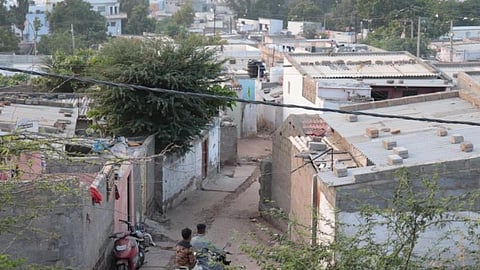
- Topics
- Feature
- Opportunities & Events
- About
- Hindi Portal
- Data
- Topics
- Feature
- Opportunities & Events
- About
- Hindi Portal
- Data

Informal housing caters to over one-third of the population in our cities, who cannot afford formal housing. Cities are known as engines of economy and this economy consists of over 90 per cent informal sector workers. However, housing requirements for these people have never got utmost priority by governments, post-independence.
Presently, it has become a major challenge to rehabilitate these settlements, which have grown organically over the time. However, the situation of these settlements in small- and medium-sized cities is quite different in comparison to large cities due to various reasons such as land prices, availability of land, economic activities, community aspirations, urban fabric, etc.
Unfortunately, slum rehabilitation programmes do not recognize these differences yet. Hence, these programmes have always focused on policy interventions focusing on metro cities, leaving the issue unresolved in small cities. In the last five years, no slum rehabilitation project has been executed in Bhuj, a city having a strong network of civil society organizations (CSOs) existing under the umbrella Homes in the City (HIC) programme in Bhuj-Kutch.
To understand the issues and progress of slum rehabilitation projects under the ongoing national housing programme Pradhan Mantri Awas Yojana (PMAY), a study conducted by a collaboration of CSOs under the HIC programme. This study highlights that the PMAY – has been unable to address slum rehabilitations in small and medium cities of Gujarat, with hardly any slums being redeveloped in the state.
Based on the “Housing for All Plan of Action Slum and Non-Slum Demand Survey Reports” prepared under the PMAY in 2015-2016, this study was undertaken by Mr. Venugopal Agrawal under the guidance of Prof. Amita Bhide, School of Habitat Studies, Tata Institute of Social Sciences (TISS), Mumbai. Around 83 such reports, available in the public domain, were used in this study.
Launched in 2015 with a vision to provide housing for all urban residents by 2022, the PMAY was designed around four verticals, namely:
The scheme is focused on increasing formal housing supply through construction of more houses either by the public or the private sector. It is mainly a supply side intervention, therefore, completely ignores slum rehabilitation.
As per the PMAY progress report till Dec 2021, there has been very little progress in terms of number of new houses constructed or upgraded in any of the slums in small towns. While only 522 units under the AHP component have been built for slums in any ULB, the progress in BLC and ISSR for slums in small towns is zero.
Table 1: Vertical Wise Demand v/s Constructed Houses in Sampled Nagarpalikas
This study highlights the main issue with regards to the implementation of BLC in slums. With slum dwellers not having access to land rights, low land value and non-feasibility of projects for developers in small cities are the two main bottlenecks for ISSR in this scenario. While developers find AHP to be non-tenable, especially in small and medium cities, AHP schemes are not suited to the needs of slum dwellers, wherever executed in the past.
Many of the detailed project reports (DPRs) have proposed that wherever land tenure of slums has not been regularized, “BLC with Tenure Regularization” can be carried out. However, no attempt has been undertaken by the state government in this direction.
Also, based on a limited sample of 74 slums for which data was provided, around 85% of slums are on public land. In 69% of our cities, after allotting 35 sq. mts. per household, there will still be land left over in the slums, which can be used for other purposes. The Odisha Model should be used as a template and modified to suit the needs of cities in Gujarat.
The study recommends that land rights which are heritable, mortgageable, transferable (after a minimum period) and support for BLC can be one of the best and most pragmatic ways for improving slums in small towns of Gujarat.
This can also have other benefits for public interest such as updating and regularization of land records, resolution of infrastructure provision challenges due to land problems, freeing up land into the land market, etc. If more people get benefit of BLC to build their houses, then the local economy also improves by generating jobs, businesses, etc., in the construction sector.
Therefore, it is prudent for the state government to introduce a structured policy and plan to provide land rights to slum dwellers, especially on public lands, in the small and medium towns of Gujarat.
The detailed report of this study can be accessed here
Author: Aseem Mishra, Director, Homes in the City (HIC) Programme, Bhuj-Kutch